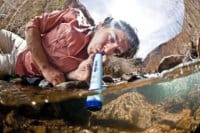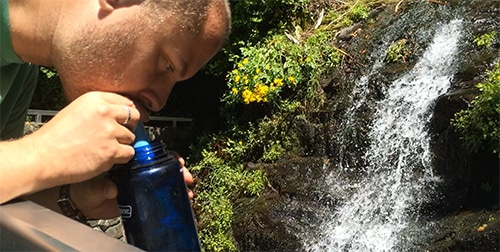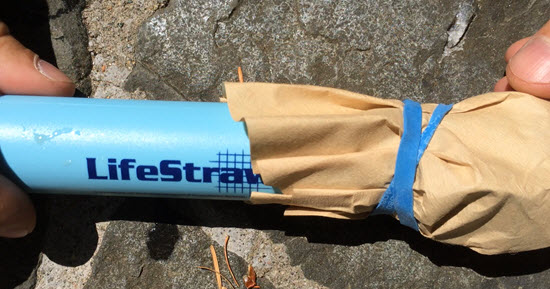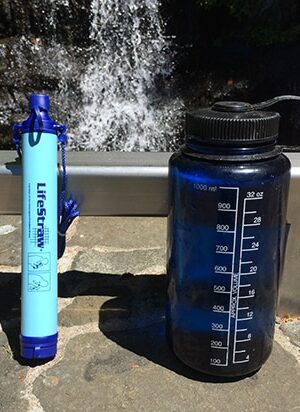
TOPICS IN THIS REVIEW… ↓(click to jump)
Importance of Filtering Water
Access to clean water is one of the most critical factors in survival.
It’s often said;
One can survive for three weeks without food but only three days without water..
Now, there are HUNDREDS of personal water filters on the market today. Each with different designs and capabilities.
Traditionally, these filters were bulky, heavy, and included mechanical parts.
More recently, UV sterilization systems have entered the market. But these methods can fail unexpectedly when batteries run low. And failures in survival can be the difference between life and death.
That’s why today I want to try out a better personal water filtration device…
The LifeStraw Water Filter Review
Over the past few weeks, we’ve had a chance to field-test the LifeStraw Personal Water Filter.
And honestly, it’s one of the most user-friendly water filtration systems out there.
With no moving parts, chemical additions, or batteries, the LifeStraw provides a lightweight, compact filter option. It can treat up to 4000L of drinking water at a very affordable price tag.
It’s an inexpensive, single-use water filter that will treat for a variety of dangerous pathogens.
Here’s a short video from Jason K. (one of Skilled Survival’s gear experts) testing and reviewing the LifeStraw:
↓ LifeStraw Review and Field Test
The LifeStraw Filter Design
The one-piece design comprises an 8” long, 1.25” diameter plastic tube with a mouthpiece on one end and an intake screen on the other. Both the mouthpiece and the intake include protective caps to keep them clean and secure.
This ensures untreated dirty water doesn’t contaminate the system – or the interior of your pack.
Inside the tube is the working heart of the filter. It’s a closely packed series of hollow-fiber membrane tubes.
The design allows water to pass while removing all particulates larger than 0.2 microns. Filter media of this size is effective against nearly all common bacteria and protozoa. As well as all suspended solids.
The LifeStraw has a listed weight of 2oz dry. But the filter material will retain another ounce of water after the first use. Despite this increase, it still ranks among the lightest filters on the market.
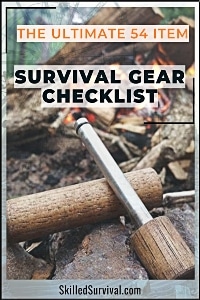
Want a free 54 item survival gear checklist?
Enter your email below to instantly download this Complete Checklist PDF. No purchase necessary. 👇 👇How To Use A LifeStraw Water Filter
Using your LifeStraw is straightforward.
You CAN drink directly from lakes, rivers, and even puddles… But filling a wide-mouthed water bottle like a Nalgene bottle is often easier, as shown below.
This allows you to drink without crouching down to the water’s surface.
It also allows you to carry some water along the trail between sources.
To use, uncap both ends of the LifeStraw. Place the inlet end into your water source and start sucking a small amount of water to wet the filter. This will start the flow of clean drinking water in mere seconds.
Straight from the package, a few initial sips of water had a slight chemical taste. However, that disappeared within a minute.
The initial flow rates are impressive. There was only a slight amount of resistance as water passed through the filter material.
Maintaining Your LifeStraw
Once you’re finished drinking, you should clear the LifeStraw of excess water.
Blow the water through the straw, shaking excess water, and recapping the ends. Over time the flow rate will drop. Or you might notice a significant increase in the amount of suction needed to produce water.
Once this occurs, blowback through the straw to clear any clogging particulates.
As the filter ends its useful life, you’ll slowly lose the ability to clear this blockage. 4,000L isn’t a hard limit.
The manufacturer has tested the LifeStraw past the designed lifespan. However, you can expect to have more difficulty producing water beyond that point.
To extend the life even further, choose the cleanest, most transparent water available to you for use. And if possible, “prefilter” before using your LifeStraw. In our experience, any mechanical filter system can benefit from a “pre-filter.”
This simple extra step will reduce the load on your LifeStraw filter, thus extending its useful life.

Want a free 54 item survival gear checklist?
Enter your email below to instantly download this Complete Checklist PDF. No purchase necessary. 👇 👇Try wrapping a clean survival bandana or paper coffee filter around the inlet of the straw. This will help remove the larger suspended materials (mud, sand, algae, etc.) from the water before entering your Life Straw.
Despite the obvious benefits of THE LifeStraw, there are some situations where it may not be the best solution.
The LifeStraw does not filter:
- Dissolved salts
- Chemicals
- Minerals
- Viruses
- Heavy metals
- Or “tastes”
Many of these items are present in the water at a molecular level. Far smaller than the 0.2-micron filter media is capable of removing. With these types of contamination, you should consider other water purification options.
Dealing With Freezing Temps
If you live in below-freezing temps, you’ll need to take the necessary precautions to protect your LifeStraw. This isn’t a flaw of the LifeStraw, as all mechanical filters are susceptible to freezing.
Just know that any amount of water left in the filter media after use could damage the filter in freezing temps.
If you choose to use a mechanical filter in winter conditions, take care to keep it from freezing.
First, carefully clear water inside the media before storing it. Keeping it inside your jacket, though chilly on the skin, will keep the filter from icing up.
Note: Running Water Is Safer
If possible, find running water to filter.
Fast moving water is usually much cleaner (and safer to consume) than stagnate water. Fast moving water will have less particulates, less bacteria and contaminated. So if you’re ever forced to drink water without having a means to filter it, running water is a better gamble.
Final Thoughts
LifeStraw started as a humanitarian relief tool.
Since 2005, it has been widely distributed in relief efforts worldwide.
Beginning in 2011, the excess supply has been available to the public for purchase. Since then, they’ve become popular for camping, hunting, backcountry, and survival situations.
The bottom line is:
- The LifeStraw is a great, lightweight tool for survival.
- It’s inexpensive and has a 5-year shelf life.
- They’re small enough to carry in a pocket and will easily treat the most common contaminants.
- This makes it a good choice to add to your emergency water supplies.
A LifeStraw is a no brainer item to add to your bug out bag, get home bag, emergency preparedness kit, car, boat, etc.
Click here to pick up your LifeStraw today.

Prepare, Adapt & Overcome,
P.s. - I just found out 2 out of 3 Americans don’t feel prepared for a 3 day disaster!!!
I guess this goes to show how modern society continues to embrace ‘living a fragile life.’ What’s crazy is… it’s so easy to fix.
To make sure YOU have the basics, watch our FREE training on “10 Simple Steps To Basic Preparedness” that shows you HOW.
Nothing crazy here… this isn’t doomsday prepping... just the basics every responsible adult should have before a disaster strikes.Why You Can Trust Skilled Survival...
Go here now to review a full breakdown of:
- Who We Are
- Our Credentials
- Our Mission
- & Product Recommendations...
Here are a few highlights of our teams credentials & certifications:
- Certified Member of a Mountain Search & Rescue Organization
- Plant Emergency & Safety Leader for a Major Food Manufacturer
- Member of the 10TH Mountain Division Hut Association
- Certifications: Avalanche 1, WFR, CPR
- Official Gear Tester for Numerous Outdoor Gear Companies
- Countless Multiday Backpacking trips into Remote Wilderness
- Bachelor's Degree In Mechanical Engineering
- Bachelor's Degree In Civil Engineering
- Bachelor's Degree In Biomedical Engineering
"It takes 20 years to build a reputation and five minutes to ruin it." - Warren Buffett
We're fully aware that trust is NOT something you GET but is EARNED.
And we'll continue to earn YOUR trust through our forthright and honest approach with each new Blog Post, Guide & Product we create...
P.s - I just took this FREE 60-second 'Readiness Score Quiz'👇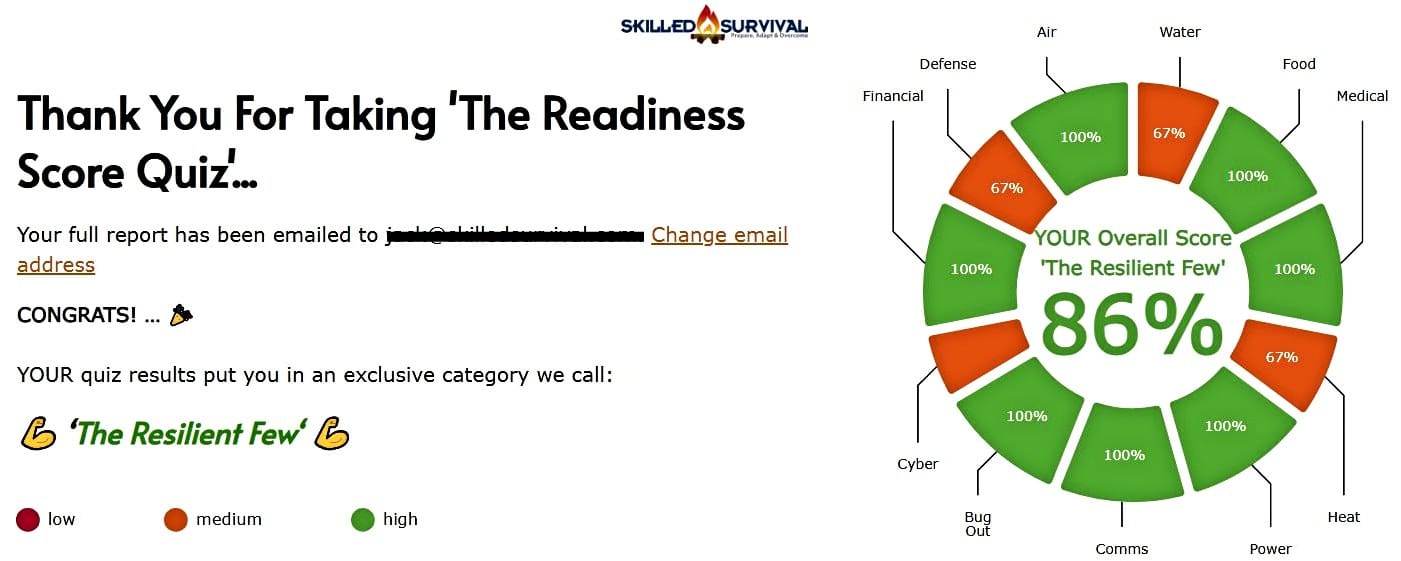
AND... I've still got a few gaps in my preps...🤔 But at least, I'm not part of 'The Fragile Masses'. 👍 Find out where YOU stand by answering a few questions...

Recommended Reading
Best Survival Bow: 16 Surprising Reasons YOU Should Get One
A survival bow is one of the most underappreciated weapons I think EVERYONE should own. Here are 16 reasons why YOU should get one today.
Best Survival Hatchets: Tough Enough To Outlast The Wild
Not all hatchets are created equal. A quality survival hatchet can do tasks even a survival knife cannot. Here's the one I carry in my pack.
Best Survival Radios: Why You Must Secure One (before SHTF)
Be the ONE who knows what the hell is going on after SHTF. Here's how to set yourself up with a reliable survival radio in a future disaster.
Best EDC Flashlight: Simple, Small, Compact & Super Bright
The best edc flashlight is durable, bright, compact and worth carrying! In this guide, we review the best one to make your search easy.
11 Proven DIY Survival Gear Projects ANYONE Can Follow
Building DIY survival gear doesn't NEED to be complicated to be effective. Here are the 11 best projects you can finish in just a few hours.
Is Tap Water Safe To Drink? The Truth Behind The Lies
Is your tap water really safe to drink? This guide provides a definite answers and a simple solution you can implement immediately.

